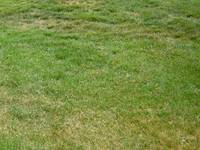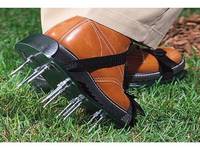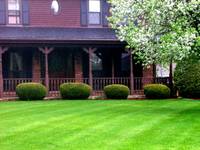Try these 5 tips to grow a lush, green lawn this spring and summer

Photo by: johnston.ces.ncsu.edu
My lawn did not fare well last summer. I tried, but it didn’t seem to want to cooperate. I wanted to get an early start on it this year, sure could use some tips.
— Nicholas P., Saline
When the sun starts sticking around longer, the snow melts away and the ground unfreezes, it's time to think about lawn care. If your maintenance program is cutting it once a week, you should know that with a few extra steps, you can enjoy a healthy, greener lawn.
When our kids were young, they loved to go out in the evenings and catch fireflies. The kids enjoyed running around barefoot in the cool grass and I knew, in the dark, that they were safe from stepping on prickers from the weeds growing in the lawn. Instead, they had a healthy, soft grass to run and play in.
Lawn hibernates in the winter, so when spring comes around, it takes a little while to “wake up.” You want to make sure you start seeing some green and that the soil isn’t too saturated with moisture before you get started on a lawn-care program. Try these steps:
Raking your lawn helps in many ways: Not only does it clear your lawn from debris, but it also also helps to de-thatch your lawn.
Once your grass is “woken up” you can tell where the thatch has built up. Thatch collects on the face of your soil just below the grass line. It's a layer of stems, roots and clippings that stay on the ground slowly decomposing.
Some thatch is good for your lawn because it keeps moisture in the ground and shields the soil from the sun. This prevents it from drying out faster.
However, an overabundance of thatch prevents sufficient water, air and nutrients from reaching the soil. This makes a perfect environment for pests to ruin your lawn. As a general rule of thumb, approximately a quarter to a half an inch is sufficient.
Aerate your lawn: Most lawn experts recommend you aerate your lawn every one to three years. Aerating your lawn helps the roots of the grass go farther down into the soil.
This process helps prevent the grass from drying out as easily because the roots can reach deeper for water.
This also makes it a straightforward process for your grass roots to get oxygen and fertilizer. There are different tools you can use for this project depending on the size of your lawn.

photo by: thatssofetch.com
Use fertilizer: The Washtenaw County website has information on how to pick the right fertilizer.
When choosing a fertilizer, consider what you are using your lawn for, the traffic on your lawn, and terrain of your lawn.
For example: Does it slope? Do you live by a water source? Is your yard mostly shaded or in direct sun?
Each variable will help determine the type of fertilizer to use and which chemical you need most. Fertilizers have three main chemicals: nitrogen, phosphorus and potassium.
Nitrogen helps the grass make the chlorophyll that gives a healthy lawn its deep green color. Phosphorus promotes strong root development and winter hardiness. Also, it makes the grass less likely to become diseased. Potassium reduces the need for water. It strengthens leaf blades, which enables grass to recover from heavy foot traffic.
Seed bare spots: Most likely some areas of the lawn did not make it through the winter, causing bare spots in the lawn. A good idea would be to plant grass seed in these areas to fix it. I usually save sawdust from my home improvement projects for times like these because spring also brings hungry birds who love grass seed. After you lay the seed, put a thin layer of sawdust on the area to deter the birds from eating it.
Stop weed growth before it starts: When my daughter was little, she loved the dandelions in the lawn, but she was most excited to find one after it transformed into its seed form and she could blow on it to watch it float away on the breeze.
Nobody really likes dandelions in their yard or the hard, unsightly crabgrass. You can get rid of them before they start.
Pre-emergence treatments are a preferred treatment of crabgrass before weed seed germination, because they are generally more effective for crabgrass control and less harmful to the turf grass. After being activated by water, these herbicides form a barrier at soil surface. When the developing seeds come in contact with the herbicide barrier, their growth is stopped.
According to Michigan State University, crabgrass germinates in the spring when soil temperature at the four-inch depth reaches 53 degrees Fahrenheit.

photo by: ronslawncare.com
I hope this gets you started. It seems like a lot of work, but with a little extra effort, you will soon be enjoying a greener, healthier lawn this summer!
Paul is a State of Michigan Licensed Builder. Paul serves as president and founding member of Nationally franchised HandyPro Handyman Service, servicing Washtenaw, Wayne and Oakland Counties. www.handypro.com. Listen to Paul every Saturday at 11 a.m. on “It’s Your Home, Let’s Talk About It” WAAM Talk 1600AM. Email questions or comments to kpaul@handypro.com.


Comments
Keith A. Paul
Mon, Apr 25, 2011 : 12:56 p.m.
Thanks for bringing this to my attention that in the City of Ann Arbor is under a mandate to reduce phosphorus loading to the Huron River in order to meet water quality standards. It is important to choose fertilizers that are in accordance to local ordnance. There are always the Green options listed here by our readers or on the Washtenaw County website. find more info here. <a href="http://www.annarbor.com/passions-pursuits/if-you-fertilize-dont-use-phosphorus-fertilizer/">http://www.annarbor.com/passions-pursuits/if-you-fertilize-dont-use-phosphorus-fertilizer/</a> <a href="http://www.annarbor.com/news/huron-river-phosphorus-levels-down/">http://www.annarbor.com/news/huron-river-phosphorus-levels-down/</a>
Dog Guy
Fri, Apr 22, 2011 : 3:52 p.m.
Through the 1950's, clover was considered part of a typical Michigan lawn. Clover fertilized lawns by fixing nitrogen. Crabgrass, dandelions, plantain, and other weeds were pulled up. Scotts marketed the postwar grainfield weedkiller 2,4-D for area spraying lawns despite that it killed clover. Scotts advertising said that their weedkiller killed lawn weeds--even clover. By calling clovers weeds, Scotts not only sold its weedkiller, but also lots more fertilizer and grass seed. If you want a greener, tougher, and easier lawn, stop area-killing weeds and fertilizing. Get a pound of dutch white clover seed ($5 @ Downtown H & G) to throw on bare spots. The bees and bunnies will thank you. You can use a spray bottle of 2,4-d to execute individual weeds--a meditative and pleasant walk in your lawn. If you want a textureless green carpet, see Jack Merkel.
Rork Kuick
Fri, Apr 22, 2011 : 5:42 p.m.
Outstanding, and with good humor. Very nice, Dog Guy. I do not treat white clover as a weed in my "lawn". People with "grub" trouble the last few years have made me wonder - is that part of the cost of having such a monoculture out there? Scott's solution: insecticides no doubt, and don't forget the fungicides while your there.
Rork Kuick
Fri, Apr 22, 2011 : 12:48 p.m.
Tip #6: Think of our river and the millions of people downstream and try not using fertilizer. Or try using half of what you used to. Fire your lawn care service. Results: spend less, mow less, perhaps water less. The writer seems to think using phosphorous is OK - it's not even permitted here, right? If we want to make claims about "healthy" lawns, let's first hear how that is measured. I'll be out there using physical methods only, and grass seed maybe. Tip #7: some shade from a few trees can help conserve water too.